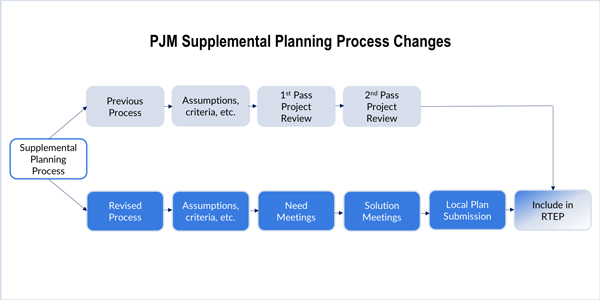By Rory D. Sweeney
PJM’s transmission owners have floated a proposal that would comply with FERC’s show cause order on their planning processes by adding input opportunities — along with complexity — for tracking project development.
PPL’s Frank “Chip” Richardson explained the process developed by the TOs and PJM during a conference call Tuesday. Instead of mirroring PJM’s existing processes for baseline projects, which are developed to address violations of regional or national reliability criteria, the process for supplemental projects will have a more detailed and structured pathway for stakeholder engagement.
Supplemental projects are transmission expansions or enhancements developed by TOs to address their individual planning criteria and maintain their assets, so they sidestep PJM’s analysis for inclusion in its Regional Transmission Expansion Plan. The new planning process was outlined in FERC’s order but has received stakeholder focus as TOs developed the implementation details.
Of particular interest to planners has been FERC’s determination that the three steps of project planning — defining assumptions and criteria for analysis, identifying needs, and choosing a solution — each receive its own meeting with time before and after to provide input. Richardson cautioned that parts of the last two might bleed into each other. When talking about a problem, “the natural question is, ‘What are you going to do about it?’” he said. “It’s hard not to talk about the solution when you talk about the need, so you’ll have to have a little bit of forgiveness.”
The proposal also clarifies that TOs can submit revisions to their local plans (which include supplemental projects) to the RTEP throughout the year. TOs said they plan to maintain their existing practice of having an annual review of the models, criteria and assumptions that underpin the projects in December or January of each year. This information supports PJM’s development of base-case planning models that allow stakeholders to model any project to see how it might change flows on the grid.
PJM’s Aaron Berner said staff are still unsure whether they will create separate slide decks to review supplemental versus baseline high-voltage projects. The difference has come under consideration because the D.C. Circuit Court of Appeals ruled earlier this month that high-voltage supplementals should be eligible for regional cost allocation and PJM staff indicated that might mean the projects have to go through the RTEP analysis. (See AMP Offers ‘Best We Can Do’ on PJM Tx Planning.)
Complexities
American Municipal Power’s Ed Tatum, who has championed a proposal to add details and rules to the TOs’ plan, highlighted several concerns with the plan’s structure. For one, he said, it’s tough for stakeholders to be prepared for meetings when the project presentations are posted 10 days prior to the meeting. AMP has members in nine states and over multiple TO zones.
Richardson acknowledged that if the goal is to model all of the potential solutions that TOs consider, “that’s quite ambitious, and it will be challenging.” He suggested stakeholders focus “on those things that would actually have some impact on them directly.”
Tatum asked whether TOs will explain why their preferred solutions are chosen over other options. Richardson said he believed TOs agreed to discuss other options that they “seriously considered,” but that they don’t plan to work on solutions “that they are not intending to pursue but may have considered.”
“I think many people had the same reaction … ‘Wow this is pretty complex,’” Richardson acknowledged.
He said TOs plan to convene stakeholder reviews of the process in the first and third quarter next year.



